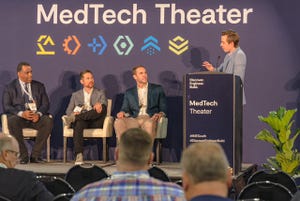Smooth Operator
Medical Device & Diagnostic Industry MagazineMDDI Article IndexOriginally Published April 2000Building Quality into the Development Process Up Front
April 1, 2000
Medical Device & Diagnostic Industry Magazine
MDDI Article Index
Originally Published April 2000
Building Quality into the Development Process Up Front
|
It's amazing, says Ross Flewelling, PhD, "how many medical device start-up companies don't do the critical experiments on their product, don't do the technical tests that will actually validate their approach, yet still get substantial funding." Flewelling has a good idea of what those critical tests are, having spent over 20 years in biomedical R&D management—a year and a half of those as a consultant to start-ups—directing the creation of more than a dozen new core technologies. "I would come in to the start-ups, and they would have this beautiful data," he says. "Then I would run an independent clinical study—it would be a random number generator—and things might not look so good."
In a market where investors are often more concerned with the high market potential of a product than with its technical feasability, Flewelling explains, there will always be money available for technologies that haven't proven themselves. But getting venture capital doesn't guarantee a successful product, and failing to do the proper trials up front endangers the product's ultimate success—and in turn, that of the company.
The key to smooth development, Flew-elling says, is "to identify those high-risk, critical issues that could really make or break" the new product, and then do the necessary studies and trials early in the process. "As soon as possible," he says, "you have to do those experiments that might really undermine the success of the product later on, so that you can devise remedies." According to Flewelling, the tendency at start-ups is to rush the product ahead and ignore potential difficulties until they become unavoidable. "Everybody just wants to be cowboys and do whatever it takes to get a product out there as quickly as possible and cut all the corners," he says. "While you might develop a product quickly that way, you won't get it through regulatory hurdles."
Flewelling knows something of that cowboy approach—he successfully took a new CO2 analyzer from concept to market in 18 months (and was given the Chief Operating Officer's Achievement Award for doing so). But even then he heeded his own advice: the scientific research and tests had already been done for a similar product. "We knew the science behind [the respiratory gas analyzer], so we knew all of the ins and outs and how to take the short cuts from the beginning." The up-front work allowed him to move extremely quickly through development; that, he says, and the fact that he and his team "worked really long hours and didn't take any vacations for a year and a half."
In his current position as chief technical officer at MediSpectra Inc. (Lexington, MA), Flewelling is working to integrate set procedures for dealing with regulatory requirements into the early development process. The company is developing a noninvasive optical technology for detecting precancerous tissue in the cervix. "One of our biggest investments in the project is in developing a quality system that will meet regulatory requirements from the beginning," he says. "We're developing a modular approach and keeping the dialog open with FDA," he says. "We're seeing them as our friends, rather than the reverse." Building these concepts into the development process from day one cuts down on some of the risk involved in launching a new product.
At the same time, however, Flewelling admits that it is the willingness to take risks that makes start-ups appealing, especially when compared to their big-brother counterparts. Large, established companies, Flewelling explains, "get narrowly locked into particular product lines and ways of doing business, and they're not willing to take risks outside their business focus."
"It's fun helping to build a company from the ground up," he adds, "getting a sense of owning the company and feeling like you helped create it." Flewelling experienced that firsthand when he joined Nellcor (now Nellcor Puritan Bennett, owned by St. Louisbased Mallinckrodt) in its pre-IPO stage 14 years ago. He watched it acquire Puritan Bennett and grow to a $2 billion company, and says it lost much of its appeal for him as it grew.
New, high-risk medical technologies, Flewelling says, "are not going to fit neatly in with most established businesses. If you want to go after something that's high risk but that would really have an impact if successful, it won't sit well with a large company."
But if you can handle the inherent risk of a start-up, "and risk really means a high probability of failure," Flewelling says, the benefits are worth it. "I recommend it to anyone."
Robert Drummond is associate editor of MD&DI.
Return to the MDDI April table of contents | Return to the MDDI home page
Copyright ©2000 Medical Device & Diagnostic Industry
You May Also Like



